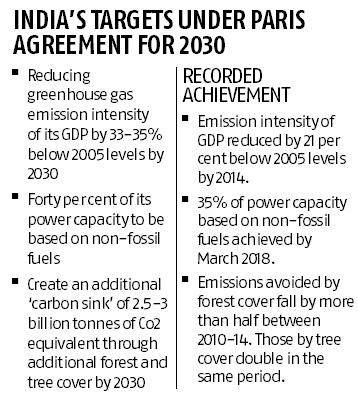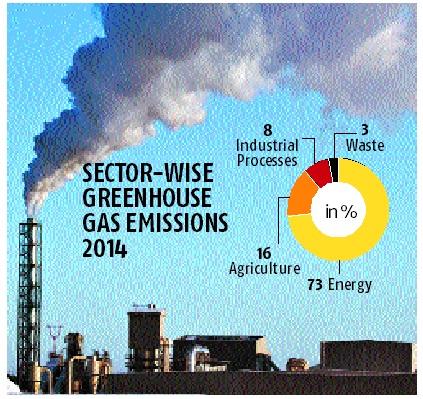Why in news?
The Union Government of India has drafted the Second Biennial Update Report which will form part of a report that India will submit to the UN Framework Convention on Climate Change this year.
What are the commitments of India under the Paris Deal?
- In the Paris Agreement, India committed to achieve the following three targets(INDC)
- India’s greenhouse gas emission intensity of its GDP will be reduced by 33-35 % below 2005 levels by 2030.
- 40 % of India’s power capacity would be based on non-fossil fuel sources.
- India will create an additional ‘carbon sink’ of 2.5 to 3 billion tons of Co2 equivalent through additional forest and tree cover by 2030.

- An Intended Nationally Determined Contribution is a public pledge from a country on how it plans to play its part in post-2020 collective action on climate change.
- These contributions are to be achieved before 2030.
What is India’s progress with respect to the targets?
- According to the Draft update report, India is set to meet 2 of its 3 Paris Agreement goals.
- India is well on way to achieve the target for emission intensity of the economy and share of non-fossil fuel-based power capacity.
- The report notes that citing Central Electricity Authority India had ensured 35 % of its capacity is based on non-fossil fuel base such as renewable, hydroelectricity and nuclear.
- Another 17-23 GW of non-fossil fuel capacity addition could take India to the target well before 2030.
- A point to remember: India did not commit internationally to the renewable energy capacity target (40 % of its capacity would be from non-fossil fuel sources, which includes large hydropower as well as nuclear power).
- In fact, at current rates of improvement on both fronts, India could achieve these targets ahead of the 2030 deadline.
- But the country has so far not been able to make start towards the target for increasing India’s forest cover.
- This goal of increasing forest cover is to create an additional carbon sink.
What are the other findings of the report?
- The report also includes how much greenhouse gas emissions India emitted in 2014 and what the growth was relative to 2005 and 2010 levels.
- The emission intensity of India’s GDP came down by 21 % below 2005 levels by 2014 recording.
- There is slightly more than 2 % annual average improvement in emission intensity.
- The rate of improvement recorded between 2010-2014 was higher than that recorded between 2005-2010.
Why India is performing poorly under the additional carbon sink goal?
- Under the Green India mission, the government is to ensure an additional ‘carbon sink’ of 2.5 to 3 billion tons of Co2 equivalent.
- It is to be achieved by greening India’s forests and enhancing the tree cover beyond the forest areas by 2030.
- On this front, India is receding further from its target rather than improving.
- Forests absorb carbon dioxide from the atmosphere and are therefore referred to as carbon sinks.
- Enhancing the forest cover locks down carbon dioxide into the soil that would otherwise have escaped into the atmosphere and added to the global warming.
- Many countries have consequently proposed to either reduce the existing rate of deforestation or enhance the rate of increase in their respective forest covers to remove additional levels of carbon dioxide from the atmosphere.
- India has reported an increase in forest cover over the past decade
- However this increase includes the enhancement in tree cover outside forest areas as well as increase in plantations and not only assisted regeneration of natural forests.
- Data from India’s draft Biennial Update Report shows that the carbon sequestration from forests has actually got worse between 2010-2014.
- Carbon removed from the atmosphere by forests is included in the emissions inventory as part of a broader category called, “Land use, land-use change, and forestry.” or LULUCF.

- The draft report pegs the 2014 levels of emission removal by forestry at only 68,215 giga tons of Carbon dioxide equivalent as compared to the 200,036 giga tons of carbon dioxide equivalent in 2010.
- But the removal of greenhouse gas emissions from the sub-category ‘croplands’ more than doubled over the same period.
- This sub-category includes emission removal from agro-forestry and tree cover outside forests.
- Emissions from croplands were pegged at 248,610 giga tons as compared to 110,757 giga tons in 2010.
Source: The Hindu

